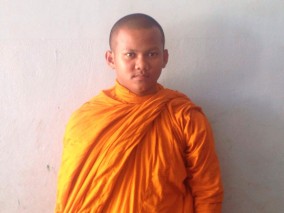
Praying for a harmonious, righteous future.
In late 2004, I was working in my New Zealand office when a startling email arrived. It was sent from an internet cafe near Pub Street, Siem Reap where half an hour online cost poor students two dollars. Back then internet access was not common.
The startling thing about the email was the headline: Big Trouble at Killing Fields Pagoda.
An incident had occurred at Wat Thmey which is on the northern edge of Siem Reap. This is the general scene of the local killing fields; though an international hotel now occupies some of that tragic land. Wat Thmey, because of its location and history has, since the late 1990s, seen a lot of tourist buses. It is a reflective place to visit I feel, with the stupa containing skulls and bones collected by my friend Savong’s father – pictured above.
But what was the Big Trouble? It turns out a couple of the senior monks were pocketing most of the donations from visiting groups – mostly Japanese and Koreans – and were doing this at the expense of the wider work of the monastery which ran a school, gave homes to homeless children, and trained young monks.
Savong described how a big group of locals had gathered, how angry words were exchanged and how the ‘bad monks’ had been sent packing. A case of village justice I think.
That account quickly unravelled my beautifully stitched together impression of all monks as being very holy people. As with any faith we might care to name; there are bound to be a few bad apples.
Here the lead paragraph from a 2010 story:
Two Cambodian Buddhist monks have been arrested in the popular tourist city of Siem Reap for smoking crystal methamphetamine along with two women in their pagoda.
Or from the Phnom Penh Post, again in 2010.
Phnom Penh – Following the turmoil surrounding the distribution by Bluetooth phone of videos showing several naked women taking their holy bath, the police uncovered more than 300 other pictures in the phone memory of a former monk. The pictures were recovered during a search and arrest made on 26 June 2010. Some of pictures were videos while others were still photos.
In that case the monk was defrocked, (he changed into civilian clothes,) before his arrest.
In 2015 in Phnom Penh six monks were arrested after beating up a mot driver, but charges were dropped. The story is complicated, but the Cambodia Daily account suggests that the driver is the one who started the fracas. He was compensated a million riel.
In 2016 there have been at least three news stories: two very serious cases of rape by individual monks, and just recently a case of 19 young Cambodian monks arrested in Phuket, Thailand for failing to have visas into Thailand, and for soliciting – begging for cash.
Stories like these occur from time to time and rightfully shock the Cambodian community, but unless I’m badly mistaken, the Buddhist church does not cover things up or further victimise victims.
I should end on a note of warning. Not all monks are legitimate. Read this excerpt from the helpful website MoveToCambodia.com
The fake monk scam. Fake monks are usually Chinese and are often (but not always) dressed in brown or mustard-colored robes, unlike the bright orange garb of their authentic Khmer counterpart, and will wear pants underneath their robes. They are usually middle-aged, while most Cambodian monks are in their twenties or even younger. Fake monks don’t usually speak any Khmer and very little English, other than to demand more money. They often wear wooden prayer beads and offer people bracelets or amulets. Fake monks will often collect money well into the night, unlike real monks who only collect in the morning. Perhaps most importantly, it’s reported that they don’t seem to know anything about Buddhism.
Love that last telltale detail!
Another characteristic of fake monks is that they argue and insist you give more than the few riel or dollars you may have donated. They’re big trouble.
For more: Another case of village justice.



You must be logged in to post a comment.